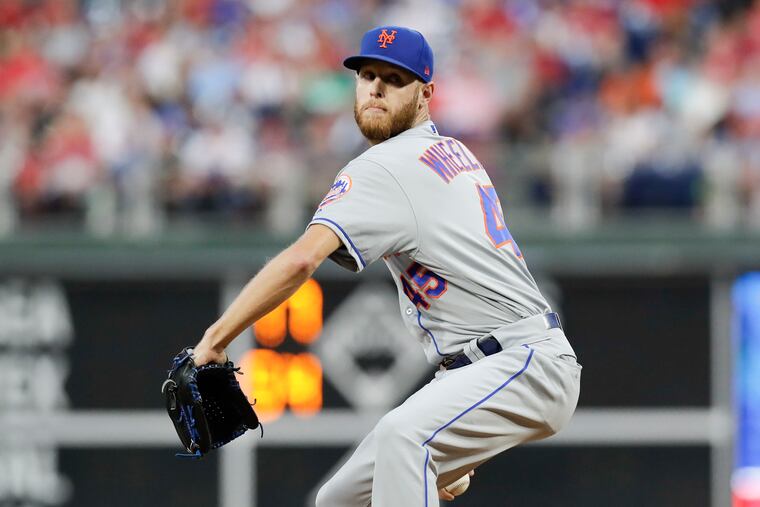Phillies stopped spending on starting pitching after signing Zack Wheeler. It was a mistake. | Bob Brookover
This year's class of free-agent starting pitchers was deep and some quality arms still remain on the open market, but the Phillies opted to leave the market after signing Zack Wheeler to a five-year deal worth $118 million.

SAN DIEGO – Phillies general manager Matt Klentak said during his final winter meetings media session that he performs a quarterly presentation for John Middleton and cousins Jim and Pete Buck, the three primary owners of the ballclub.
“One of the slides that we always show them are the future free-agent classes to serve as a reminder that what we’re doing today, this is not the last time that we’re going to have a chance to add a player,” Klentak said. “There are more good players to come next year and the following year. We do this for everybody’s benefit to remind ourselves of that.”
It’s a valid point and it should also be noted that even though the Phillies have opted to stay below the $208 million payroll tax threshold going into the 2020 season, it’s possible they could surpass that number during the season. If they are in contention, they should, in fact, be willing to go after one of the future free agents being dangled at the trade deadline.
The problem with that line of thinking is this: There is no way to know right now who might be available at the trade deadline and the price for star in-season talent also includes top prospects.
By refusing to cross the payroll tax threshold during this offseason, the Phillies are bypassing some players who could have taken them from playoff contenders to prohibitive favorites for one of the National League’s five postseason spots. And isn’t that what everybody wants in Philadelphia after an eight-year playoff drought that is the fifth longest among baseball’s 30 teams?
Klentak is right about the next two free-agent classes from a positional standpoint. Houston’s George Springer and Boston’s Mookie Betts and Jackie Bradley Jr. could be among the outfielders in next year’s class. And in two years, Colorado’s Nolan Arenado and the Cubs’ Kris Bryant, who rank right up there with Anthony Rendon as the best third basemen in the game, are potential free agents.
“We know that some of those players will never reach free agency,” Klentak said. “Or they may reach free agency in a far different status than they’re in today. I also know … you don’t necessarily want to build your team through free agency. There are going to be some years like last year and maybe even this year where we’re making some high-profile acquisitions through free agency, but the hope is that we’re not doing that every year.”
» READ MORE: Matt Klentak on Phillies’ starting pitchers: Aaron Nola, Zack Wheeler ‘as good as any twosome you’ll find’
Time will tell if the Phillies will get another shot at some of the game’s elite players, but the thing that made this year’s free-agent class truly special is the depth of the starting pitching, which is the thing that every team wants and needs.
It’s understandable that the Phillies did not want to get into a bidding war with the Yankees over Gerrit Cole, who received a nine-year deal worth $324 million. And Stephen Strasburg wanted to stay with the Washington Nationals because that’s where he is most comfortable.
The five-year, $118 million deal the Phillies gave Zack Wheeler could well end up being the third biggest contract paid to a starting pitcher. Madison Bumgarner, who is being wooed by the Angels, Dodgers, and the Giants, could end up with more, but not much more.
The Phillies obviously did not go cheap after forking over the most combined free-agent dollars in the previous two offseasons. When all is said and done, their payroll will likely be among the top five in baseball.
But they did not get a sure thing in Wheeler. Consider this: Over the last three seasons, Bumgarner, Dallas Keuchel, and Hyun-Jin Ryu all have a lower earned run average than Wheeler. They also have comparable innings pitched. They are all still unsigned. So are Alex Wood and Julio Teheran, who seem like better fourth- and fifth-starter options than Zach Eflin, Nick Pivetta, and Vince Velasquez.
When Klentak shows Middleton and the Buck cousins the potential free-agent starting pitchers for next season and the year after, it’s hard to believe they will be as impressed as they were by what was on the board this year.
The top names in next year’s class are Trevor Bauer, Robbie Ray, James Paxton, Masahiro Tanaka, Jake Arrieta, Marcus Stroman, and Jose Quintana. Paxton is the best of that bunch, but the Yankees are unlikely to let him get away if he remains elite.
In two years, the class of potential starting pitchers will consist of Noah Syndergaard, Clayton Kershaw, Corey Kluber, Max Scherzer, Justin Verlander, Zack Greinke, Chris Archer, and Mike Foltynewicz.
Many of the names are intriguing, but Kershaw will be headed into his age 34 season with a ton of mileage on his arm. Verlander will be 39, Greinke will be 38, and Kluber will be 36.
This would have been a great year to add more than one starting pitcher, but the Phillies opted to stop spending on their weakest link after signing Wheeler. Given the depth and quality of this year’s class, it sure looks like a mistake.